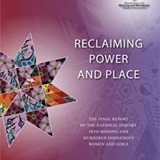 It has now been two weeks since the release of Reclaiming Power and Place, the final report of the MMIWG Inquiry. My first response was to be incredibly impressed with the thoughtfulness and thoroughness of 728 pages. Too much for one reading. Instead, I decided to reflect chapter by chapter. Even that will require at least twelve steps.
It has now been two weeks since the release of Reclaiming Power and Place, the final report of the MMIWG Inquiry. My first response was to be incredibly impressed with the thoughtfulness and thoroughness of 728 pages. Too much for one reading. Instead, I decided to reflect chapter by chapter. Even that will require at least twelve steps.
“Canada needs to challenge institutions that violate basic human rights.” Yes, that is a position I can readily support!
“We need a new decolonized social order.” If colonization means establishing control over an Indigenous population, we must be aware of the extent to which dominant culture negates the value of those defeated. Victory does not equate with superiority, and yet the intent of “assimilation” was that conquered people would become more like their oppressors than vice versa.
“Healing centres are needed.” Of course. “The Inquiry marks the beginning not the end of the process.” Agreed. Return to wholeness for Indigenous women of Canada means reclaiming their power and place in society. So-called “assimilation” resulted in a number of racist and sexist terms which devalue women. Even the euphemism “high risk lifestyle” suggests those who disappear carry responsibility for the circumstances that created vulnerability. It is time to break the cycle of violence and shame.
“We need to protect rather than protest.” (p.38) Spirituality is important. “Our women and girls are sacred.” (p.39) Sacredness has a multi-faceted meaning: Creator-gifting, Creator-centered thinking , using gifts for the good of humanity, sharing and bringing new life in community, encompassing the balance of male/female, following the teachings of kindness, respect, truth, honesty, humility, love and wisdom.
“What we serve is the wholeness in each other and in life.” (p.46) Service is mutual.
This brings us to the big question. What happened that women once considered sacred within their own culture became a hunted and disposable population in Canada?
The original meaning of genocide is defined as “coordinated plan of different actions aimed at the destruction of essential foundations of the life of national groups…” (p.51) It is described as occurring across several different fields:
- Political – disintegration of political institutions. (The government drafted treaties to gain control of territory across Canada.)
- Social – imposition of new justice systems. (Newly conquered people were subject to Canadian laws, movement was restricted, and they were not allowed a vote in their new government.)
- Cultural – including forbidding the use of language in schools. (This happened in residential schools across Canada where children were removed from their families, stripped of their traditional clothing and way of life, and subjected to unfamiliar chores and expectations.)
- Economic – destruction of the financial base. (Treaties determined where and how Indigenous people were to be contained; new settlers were not restricted to designated trap lines.)
- Biological – measures aimed at decreasing birthrates. (Inequity of health services across Canada continues to be a scandal.)
- Physical – endangering health and mass killings. (Vulnerable women have become targets of “domestic” abuse as well as serial killers. Hence, the Inquiry.)
- Moral – attempts to create an atmosphere of moral debasement and unworthiness. (One need only look at the example given where racist and sexist slurs were used even in a court of law.)
While Canadians today may well protest that they are not responsible for historical decisions, we must acknowledge the historical reality that so-called “assimilation” attempted to destroy another nation. Reconciliation in the present must include increased awareness through public education and conscious attempts to restore equality through government action.
The Final Report mentions 1000 hours of truth testimony. My concern is that many more stories were not heard. 1000 hours is less than one each for the thousands of MMIWG identified. We assume the stories heard are representative.
The Inquiry also offers an expanded understanding of violence. (p.75) Most readers are familiar with a range of intentional or threatened use of power and force such as physical, sexual, emotional humiliation, psychological threats, spiritual belittling, cultural isolation, verbal, financial, and neglect. The Report expands the definition to include:
- Colonial violence – dehumanization by depriving people of the necessities of life, ignoring their knowledge and capacity, and using constructs to deny their ongoing presence and dignity… It is linked to racism and … contributed to economic, social, and political marginalization… (p.76)
- Cultural violence– forced assimilation of white-dominant mainstream culture with embedded racism (p.77)
- Institutional violence– “status quo” perpetuated by the military, church, educational system, health system, police, emergency responders, and justice system.
Together these lead to structural violence, best understood as “the gap between a person’s or community’s well-being, when that difference is avoidable.”
“Because these structures sill exist today, decolonization is a key concept… We need to create space for an Indigenous perspective. This means re-establishing strong contemporary Indigenous Peoples, Nations, and institutions based on traditional values, philosophies, and knowledge systems.” (p.78)
The Report seems to rely on the premise that violence is preventable in a transformed society. Of course it is, and many things would be different in a loving and benevolent society. There would be kindness, equality, openness, encouragement, respect, justice and hope. The question is: How do we get there? What will the next chapters suggest?

